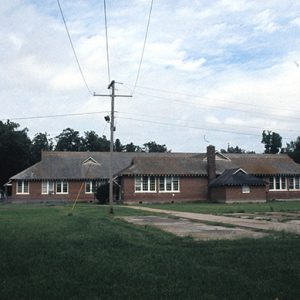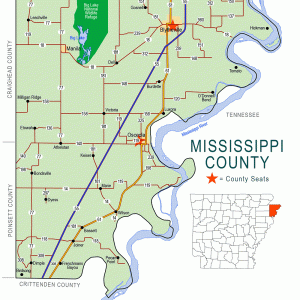calsfoundation@cals.org
Burdette (Mississippi County)
| Latitude and Longitude: | 35°49’02″N 089°56’21″W |
| Elevation: | 243 feet |
| Area: | 0.74 square miles (2020 Census) |
| Population: | 140 (2020 Census) |
| Incorporation Date: | May 10, 1905 |
Historical Population as per the U.S. Census:
|
1810 |
1820 |
1830 |
1840 |
1850 |
1860 |
1870 |
1880 |
1890 |
1900 |
|
– |
– |
– |
– |
– |
– |
– |
– |
– |
– |
|
1910 |
1920 |
1930 |
1940 |
1950 |
1960 |
1970 |
1980 |
1990 |
2000 |
|
– |
100 |
155 |
110 |
122 |
115 |
173 |
328 |
148 |
129 |
|
2010 |
2020 |
|
|
|
|
|
|
|
|
|
191 |
140 |
|
Burdette (Mississippi County) is located nine miles south of Blytheville (Mississippi County) on State Highway 148 just off U.S. Highway 61, known as the Great River Road. Burdette is named after Alfred Burdette Wolverton, who in the early 1900s was one of the first lumbermen to settle in the area. It was incorporated as a company town by workers of the Three States Lumber Company of Wisconsin in May 1905. Prior to Three States Lumber Company’s arrival, the area had been swampland and uninhabitable. Burdette Township split from Fletcher Township in 1908 to create the community of Burdette. Burdette proper is located within the larger Burdette Township (a township being a division of a county), which includes farming and lumber operations.
Three States Lumber Company finished construction of the first sawmill in Burdette in June 1906. By 1922, the town had a hotel, wooden sidewalks, a power plant, a cooperage company, two separate schools (for black and white children), a large park with a baseball diamond, an open-air theater, a community canning kitchen, a post office, and an ice cream parlor. The Blytheville, Burdette, and Mississippi River Railroad was incorporated in 1906 with a line from the Burdette mill to Wolverton Landing on the Mississippi River. The track was later extended from Blytheville to Luxora (Mississippi County).
Daniel Tucker was the first African American known to own land in Burdette. This land later became known as Tuckertown, or the black portion of Burdette. According to the 1900 census, Tucker and his wife, Mary, lived in Clear Lake Township of Mississippi County. He moved to Fletcher Township in 1903, where he became a leader in the developing black community. Tucker was also one of the original signers of the petition to incorporate Burdette Township in 1905.
During the company’s seventeen years of logging operations in Burdette Township, Three States sold its cut-over lands to farmers, and the population of the entire Burdette Township reached more than 900 by 1920.
In the fall of 1913, Three States Lumber Company hired James Feagin Tompkins to manage the company’s “home farm,” or what became known as the Burdette Plantation. While tenancy and sharecropping were already on the rise in Mississippi County, Tompkins introduced the crop-lien system to Three States’ operation. With the hiring of Tompkins and the creation of the Burdette plantation, the Three States Lumber Company town of Burdette began a transition from a company-operated lumber town to an independently owned agricultural community.
Three States Lumber Company systematically sold the land in and around the town of Burdette to local businessmen and farmers over the course of forty years. Three States invested heavily in its Burdette plantation even with major economic and environmental crises. The company maintained a viable agricultural business through the exploitation of their tenants and sharecroppers. However, Three States found a way, eventually, to get out of its agricultural interests by allowing its tenants to lease to buy throughout the 1920s and 1930s, decades that saw some of the worst agricultural depressions the United States had ever experienced.
Three States Lumber Company leased the 2,200-acre Burdette plantation to James Feagin Tompkins and a group of investors in 1922 with the option to buy. The Burdette plantation served as a testing ground for agricultural research development by the University of Arkansas (UA) in Fayetteville (Washington County) beginning in 1923. Burdette became known for its advancements in agricultural production in the mid-twentieth century. In conjunction with the Arkansas Agricultural Experiment Station and the U.S. Department of Agriculture Bureau of Plant Industry, agronomists conducted cotton and corn varietal and fertilizer experiments. They tried new types of seed and fertilizer to improve cotton yields. Several different cotton varieties and strains were developed by breeders through these testing trials located west of the plantation headquarters. These included Burdette Express, Burdette Lone Star, Burdette Trice, Burdette Acala, and Burdette Delfos. As a result, Burdette became locally celebrated for its many different varieties of cotton and corn.
Three States offered a lease-with-option-to-purchase cotton contract to Burdette farmers and the Burdette Plantation in 1932. The contract called for 100 bales of cotton in payment for forty acres of land and was not contingent on the price of cotton. This unique plan for agricultural development in the Mississippi River Valley was seen as progressive for its time but also served the interests of Three States in removing itself from its agricultural enterprise in Burdette. Cotton prices increased as a result of the New Deal programs, and cotton growers like Tompkins received government subsidy and parity payments. Tompkins and his investors were able to purchase the Burdette Plantation by 1935.
Burdette thrived as an active farming community until the 1960s, when the mechanization of agriculture and development of chemical weed control decreased the demand for labor. The Blytheville School District and Burdette High School consolidated in the early 1990s, and the Blytheville School District closed the Burdette schools in 2001. The Burdette School Complex Historic District is on the National Register of Historic Places for its historic architecture and significance to a once thriving lumber and agricultural community. There are currently no churches or businesses in the community.
For additional information:
Biographical and Historical Memoirs of Northeast Arkansas. Chicago: Goodspeed Publishing Company, 1889.
“Burdette School Complex Historic District.” National Register for Historic Places nomination form. On file at Arkansas Historic Preservation Program, Little Rock, Arkansas.
Fischer, Duane Dale. “The John S. Owen Enterprises.” PhD diss., University of Wisconsin–Madison, 1964.
Forrester, Jami Marie. “From Swamp Forest to Cotton: Three States Lumber Company and the Development of Burdette, Arkansas, in the Early Twentieth Century.” PhD diss., University of Arkansas, 2011.
Hale, Ruth Carlton. James Feagin Tompkins and the Burdette Plantation. Blytheville, AR: Post Impressions, 2005.
John S. Owen Lumber Company Records, 1875–1955. Special Collections and Archives, McIntyre Library. University of Wisconsin–Eau Claire, Eau Claire, Wisconsin.
Whayne, Jeannie M. Delta Empire: Lee Wilson and the Transformation of Agriculture in the New South. Baton Rouge: Louisiana State University Press, 2011.
———. A New Plantation South: Land, Labor, and Federal Favor in Twentieth-Century Arkansas. Charlottesville: University Press of Virginia, 1996.
Whayne, Jeannie M., and Willard B. Gatewood, eds. The Arkansas Delta : Land of Paradox. Fayetteville: University of Arkansas Press, 1993.
Jami M. Forrester
Springdale, Arkansas
 Mississippi Alluvial Plain
Mississippi Alluvial Plain Burdette School Complex Historic District
Burdette School Complex Historic District  Burdette School Complex Historic District
Burdette School Complex Historic District  Mississippi County Map
Mississippi County Map 




Comments
No comments on this entry yet.